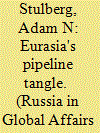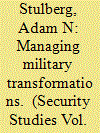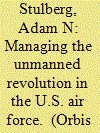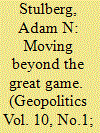| Srl | Item |
| 1 |
ID:
107974


|
|
|
| 2 |
ID:
058967


|
|
|
| 3 |
ID:
069889


|
|
|
|
|
| Publication |
2005.
|
| Summary/Abstract |
How did the U.S. Navy successfully manage the carrier revolution? This hallmark case challenges traditional explanations of organizational change. Decisive reforms were enacted. The new vision of naval warfare thrived before the "old" battleship-centric orthodoxy was discredited, before it was fully understood, and before its champions seized power within the service. This article posits a modified principal-agent framework to explicate systematically the interplay between new interests and ideas that lie at the crux of managing the diffusion of innovations within military organizations. The main finding is that the nebulous exploration and outcome of transformation rests on strategies employed by service entrepreneurs for lowering the material cost of oversight and invoking established managerial norms that align incentives and "common knowledge" for change within military hierarchies. Evidence from the U.S. Navy's interwar experience with carrier aviation illustrates this administrative dimension to organizational change. The conclusion reviews directions for extending the argument, and lessons for managing contemporary military transformation.
|
|
|
|
|
|
|
|
|
|
|
|
|
|
|
|
| 4 |
ID:
077118


|
|
|
| 5 |
ID:
060798


|
|
|
|
|
| Publication |
2005.
|
| Summary/Abstract |
Emboldened by the recovery of the domestic oil industry and determined to exploit comparative advantages in world markets, President Putin put Russia once again on the move to secure control over Caspian energy spoils. The revitalization of Moscow's posture renewed debate over the contours of geopolitical competition in the region, and the effectiveness of non-military instruments of statecraft more generally. Yet, much of the controversy is misplaced due to empirical and theoretical oversights. The first is due to a misreading of the record of Moscow's Caspian energy posture, and an under-appreciation for the mixed success of Russia's energy leverage across the oil and gas sectors. The second comes from the failure to understand the conditions under which institutionally weak states can manipulate markets and regulatory mechanisms in global energy relations for purposes of national security. The article offers a first cut at substantiating these claims by examining the geoeconomic dimensions to Russia's Caspian energy policy.
|
|
|
|
|
|
|
|
|
|
|
|
|
|
|
|
| 6 |
ID:
191981


|
|
|
|
|
| Summary/Abstract |
There is much ado nowadays about the flagging commercial nuclear industry in the United States. Although the country maintains the largest global fleet of reactors, more than one-third operate at a loss, and the industry is on pace to lose more than 20 percent of its generating capacity by 2050.Footnote1 This crisis is unfolding as Russia’s state-owned nuclear industry has become the largest global supplier of new nuclear reactors, driven by its build-own-operate export model and Russian government financing for international reactor projects. This financing is “large (in total amount provided), cheap (with low interest rates) and long-lived (with long repayment periods).”Footnote2 Not surprisingly, many US nuclear officials, policy experts, and corporate leaders fear that without concerted government intervention, the US nuclear industry is teetering on the precipice of irrelevance as a strategic global supplier, just as the prospects for long-term strategic confrontation with Moscow are materializing with Vladimir Putin’s war in Ukraine.Footnote
|
|
|
|
|
|
|
|
|
|
|
|
|
|
|
|